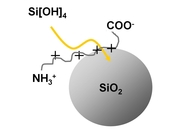
Diatoms are unicellular photoautotrophic organisms that protect themselves by a silica-based cell wall. Besides amorphous SiO2 polymers, the cell wall contains long-chain polyamines and silaffins. The latter are short cationic peptides with characteristic post-translational modifications. Both polyamines and silaffins appear to be involved in the polymerization of monosilicic acid [Si(OH)4] to silica (Kröger et al., Proc. Natl. Acad. Sci. USA 97, 14133-14138, 2000; Kröger et al., J. Biol. Chem. 276, 26066-26070, 2001).
Starting out from recombinant silaffin, we construct peptides for initiating silica polymerization. Both the length of these peptides and their amino acid sequences are varied and assessed with regard to silica precipitation (Ref.: Roeder et al., 2014; Zerfaß et al; 2015). In collaboration with Prof. W. Tremel (Inorganic chemistry, Mainz JGU) we have constructed by „phage display“ a peptide which binds specifically to the polymorph of calcium carbonate, vaterite (Ref.: Schüler et al., 2014, Spinthaki et al. 2017, Zerfaß et al. 2017).